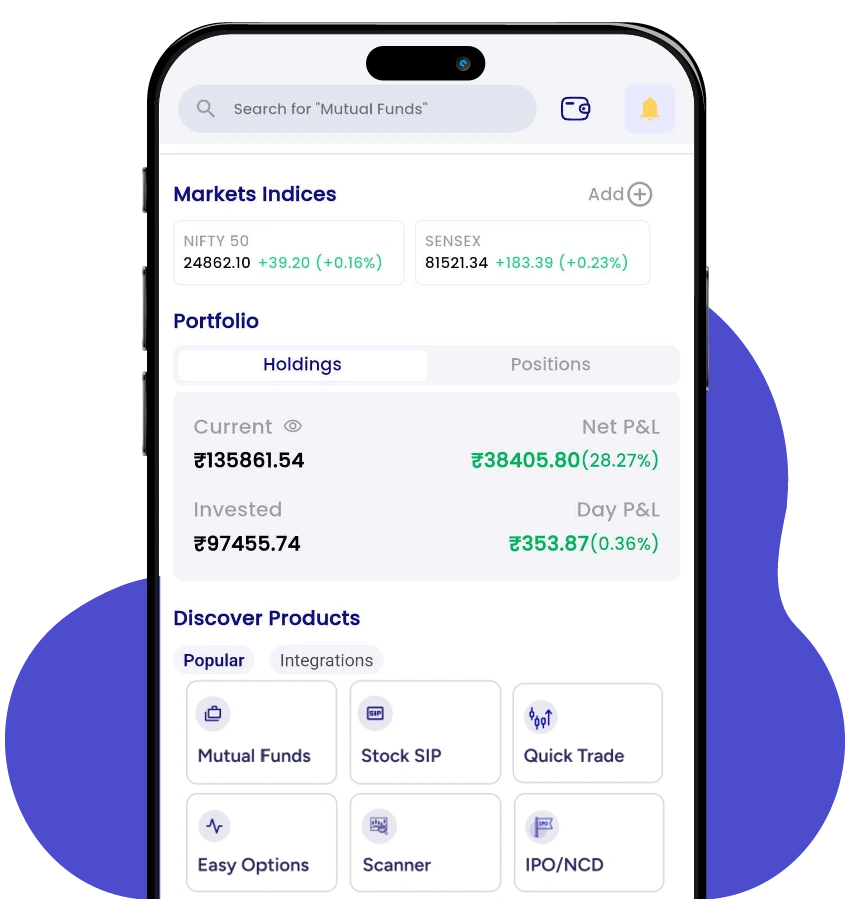What is a Portfolio in the Stock Market?
- 26th June 2025
- 5 min read
What is Portfolio might be a question in your mind, arrived out of curiosity, or you want to learn about it in detail. In the investment context, your portfolio is a mere collection of your securities or assets, in which you have invested and expect them to generate returns.
You may be a seasoned investor or a new one, but your investment portfolio is an important tool to grow your wealth. Therefore, learning and developing a diversified and well-rounded portfolio is the key to achieving the long-term success you aim for.
Read this blog and learn specific facts about a portfolio, its types, benefits and key mistakes to avoid to build a proper portfolio.
Definition of a Portfolio
When you invest in the securities market and build a collection of a wide variety of assets, it is called your portfolio. Depending on your investments, your portfolio can contain stocks, bonds, gold, funds, cash equivalents, etc.
You can also think of it as a basket of financial assets, where you keep assets from different classes to achieve a collective goal of income generation, capital gain, risk mitigation, etc.
What are the Different Types Of Portfolios in Investment?
Now that you have an idea of what is Portfolio, understanding the types of portfolios will help you stay informed about investments. Here is a detailed breakdown of portfolios you can build:
-
Income Portfolio
As the name implies, you build an income portfolio if you are focusing on a regular income from your investments in securities. Such portfolios include securities, such as stocks with regular dividend payouts, debt securities, bonds, etc.
-
Growth Portfolio
If you are focused on capital gains, this portfolio type may be suitable for you. You can build such a portfolio by investing in company stocks with higher growth, ETFs, mutual funds, etc. Such a portfolio ensures capital gain over a longer period after investments.
-
Value Portfolio
You can build a value portfolio by investing in undervalued assets that have a higher potential for gains. You should look for companies that have good fundamentals, but whose share value is lower than their intrinsic value. You can buy such securities at a discounted price and benefit from higher return potential when stock prices rise.
-
Hybrid Portfolio
If you focus on building a hybrid portfolio, you must focus on adding two types of assets, such as debt and equity. Equities will help you build wealth and higher returns, but have a higher risk. With debt securities, you can enjoy steady income over time.
What is the Importance of Building a Portfolio?
After understanding what is meant by portfolio, it is necessary to understand its importance. By managing your portfolio efficiently, you can increase the potential to generate profits and avert risks.
You can develop strategies to rebalance asset allocation depending on market situations. Moreover, based on the current market needs and financial conditions, it enables you to make a quick investment customisation. Having a good portfolio is important to choose investment options that are efficient under market conditions and help distribute resources accordingly.
Pros and Cons of Having a Portfolio
Take a look at the following section and take note of the pros and cons of having a portfolio, aside from learning what a portfolio means:
-
Ensures Income Flow
Your portfolio allows you to manage the assets stored in it for liquidity requirements, enabling you to have a steady income flow.
-
Helps With Diversification
With a portfolio, you can diversify your investment strategy and invest in separate asset classes. It helps to manage risks, especially during market fluctuations.
-
Risk of Return Dilution
While building a portfolio helps with diversification, there is a disadvantage. If you spread your investments too thin, there is a risk of diluting potential returns.
Common Mistakes to Avoid While Building a Portfolio
Take note of the following tips to avoid mistakes while building your investment portfolio:
- One of the common mistakes is over- or under-diversification, which can harm your potential return, and you must avoid it.
- Also, do not get emotionally attached to a particular asset, as it can harm your returns.
- Avoid timing the market, as it leads to missed investment opportunities, as timing the market is difficult.
Conclusion
Learning what is portfolio is crucial for a seasoned investor or a new one. Depending on your financial goal, you can choose a type of portfolio for an optimised return. An efficient portfolio helps asset diversification, but over-diversification might lead to losses.
FAQ’s
1. What is the difference between a portfolio and a resume?
A portfolio is a financial basket containing all your investment securities. Whereas, a resume is suitable for showcasing your education, experience, skills, etc.
2. How often should you update your portfolio?
You should monitor or track your investment progress regularly for an optimised return. You should update it every three to six months for maximum returns.
3. Can beginners start building an investment portfolio?
Yes, it is important to build a portfolio by assessing your investment strategy, risk appetite, etc.





